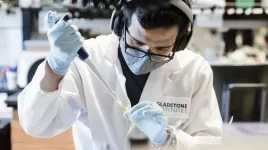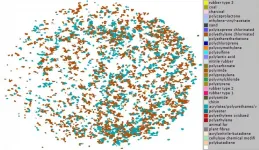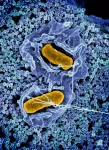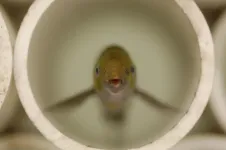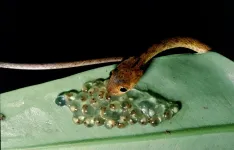Study of promising photovoltaic material leads to discovery of a new state of matter
McGill University researchers gain new insight into the workings perovskites that could lead to more efficient and cheaper solar cells
2021-05-26
(Press-News.org) Researchers at McGill University have gained new insight into the workings of perovskites, a semiconductor material that shows great promise for making high-efficiency, low-cost solar cells and a range of other optical and electronic devices.
Perovskites have drawn attention over the past decade because of their ability to act as semiconductors even when there are defects in the material's crystal structure. This makes perovskites special because getting most other semiconductors to work well requires stringent and costly manufacturing techniques to produce crystals that are as defect-free as possible. In what amounts to the discovery of a new state of matter, the McGill team has made a step forward in unlocking the mystery of how perovskites pull off this trick.
"Historically, people have been using bulk semiconductors that are perfect crystals. And now, all of a sudden, this imperfect, soft crystal starts to work for semiconductor applications, from photovoltaics to LEDs," explains senior author Patanjali Kambhampati, an associate professor in the Department of Chemistry at McGill. "That's the starting point for our research: how can something that's defective work in a perfect way?"
Quantum dots, but not as we know them
In a paper published May 26 in Physical Review Research, the researchers reveal that a phenomenon known as quantum confinement occurs within bulk perovskite crystals. Until now, quantum confinement had only been observed in particles a few nanometres in size - the quantum dots of flatscreen TV fame being one much-vaunted example. When particles are this small, their physical dimensions constrain the movement of electrons in a way that gives the particles distinctly different properties from larger pieces of the same material - properties that can be fine-tuned to produce useful effects such as the emission of light in precise colours.
Using a technique known as state-resolved pump/probe spectroscopy, the researchers have shown a similar type of confinement occurs in bulk caesium lead bromide perovskite crystals. In other words, their experiments have uncovered quantum dot-like behaviour taking place in pieces of perovskite significantly larger than quantum dots.
Surprising result leads to unexpected discovery
The work builds on earlier research which established that perovskites, while appearing to be a solid substance to the naked eye, have certain characteristics more commonly associated with liquids. At the heart of this liquid-solid duality is an atomic lattice able to distort in response to the presence of free electrons. Kambhampati draws a comparison to a trampoline absorbing the impact of a rock thrown into its centre. Just as the trampoline will eventually bring the rock to a standstill, the distortion of the perovskite crystal lattice - a phenomenon known as polaron formation - is understood to have a stabilizing effect on the electron.
While the trampoline analogy would suggest a gradual dissipation of energy consistent with a system moving from an excited state back to a more stable one, the pump/probe spectroscopy data in fact revealed the opposite. To the researchers' surprise, their measurements showed an overall increase in energy in the aftermath of polaron formation.
"The fact that the energy was raised shows a new quantum mechanical effect, quantum confinement like a quantum dot," Kambhampati says, explaining that, at the size scale of electrons, the rock in the trampoline is an exciton, the bound pairing of an electron with the space it leaves behind when it is in an excited state.
"What the polaron does is confine everything into a spatially well-defined area. One of the things our group was able to show is that the polaron mixes with an exciton to form what looks like a quantum dot. In a sense, it's like a liquid quantum dot, which is something we call a quantum drop. We hope that exploring the behavior of these quantum drops will give rise to a better understanding of how to engineer defect-tolerant optoelectronic materials."
INFORMATION:
About the paper
"Polaronic quantum confinement in bulk CsPbBr3 perovskite crystals revealed by state-resolved pump/probe spectroscopy" by Colin D. Sonnichsen et al. was published in Physical Review Research.
DOI: https://doi.org/10.1103/PhysRevResearch.3.023147
[Attachments] See images for this press release:
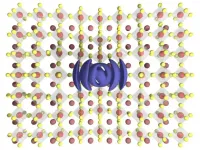
ELSE PRESS RELEASES FROM THIS DATE:
2021-05-26
SAN FRANCISCO, CA--May 26, 2021--In January 2021, reports of a new coronavirus variant that had emerged in California raised many concerns. Preliminary data suggested that it is more transmissible than the unmutated strains of SARS-CoV-2 (the virus that causes COVID-19) from which it evolved.
Now, a multifaceted collaboration between researchers at UC San Francisco, Gladstone Institutes, and other organizations across California provides a comprehensive portrait of the variant--including its interaction with the immune system and its potential to spread.
"Our ...
2021-05-26
Even though people stayed in touch during the pandemic's stay-at-home orders and social distancing, it was easy to feel out of touch with loved ones.
Technology and the internet have expanded the way humans communicate and added much to that communication -- think emojis, GIFs and memes. But they can still fall short of being physically with someone.
"Our social cues are limited online," said Fannie Liu, a research scientist at Snap Inc who earned her Ph.D. from the Human-Computer Interaction Institute in Carnegie Mellon University's School of Computer Science. "We're exploring a new way to support digital connection through a deeper and more internal cue."
Liu was part of a team from CMU, Snap and the University ...
2021-05-26
A new study looking across a large body of research finds further evidence for the safety of vaccines that are Food and Drug Administration-approved and routinely recommended for children, adults and pregnant women. The study updates a vaccine safety review that was released by the federal Agency for Healthcare Research and Quality in 2014.
"This in-depth analysis found no evidence of increased risk of serious adverse events following vaccines, apart from a few - previously known - associations," said Susanne Hempel, director of the Southern California Evidence Review Center.
The meta-analysis, ...
2021-05-26
In cities, heavy rains wash away the gunk collecting on sidewalks and roads, picking up all kinds of debris. However, the amount of microplastic pollution swept away by this runoff is currently unknown. Now, researchers in ACS ES&T Water report that stormwater can be a large source of microplastics and rubber fragments to water bodies and, with a proof-of-concept experiment, show that a rain garden could keep these microscopic pieces out of a storm drain.
Most cities' storm drains end up discharging directly into wetlands, creeks or rivers. Rainwater running into these drains becomes a concoction of whatever is on the ground, including dirt and grass clippings, leaked car fluids, fertilizer and garbage. Recently, researchers also found that ...
2021-05-26
Scientists have got up close and personal with human sewage to determine how best to measure hidden and potentially dangerous plastics.
As the way microplastics are measured and counted varies from place to place, there is no agreed understanding of the weight of the problem. Until scientists can agree on one way of measuring them, life on land and sea will continue to ingest who knows how much plastic, affecting health for generations.
A new study, published today in Analytical and Bioanalytical Chemistry, by the University of Portsmouth has examined one method, using a chemical solution called 'Fenton reagent' to ...
2021-05-26
WHAT:
The immune system's attempt to eliminate Salmonella bacteria from the gastrointestinal (GI) tract instead facilitates colonization of the intestinal tract and fecal shedding, according to National Institutes of Health scientists. The study, published in Cell Host & Microbe, was conducted by National Institute of Allergy and Infectious Diseases (NIAID) scientists at Rocky Mountain Laboratories in Hamilton, Montana.
Salmonella Typhimurium bacteria (hereafter Salmonella) live in the gut and often cause gastroenteritis in people. The Centers for Disease Control and Prevention estimates Salmonella bacteria cause about ...
2021-05-26
The COVID-19 pandemic has seen scientists perform incredible feats in a short amount of time, from developing tests to new types of vaccines. Despite these victories, experts are still working to develop an effective antiviral drug to kill the SARS-CoV-2 virus. A cover story in Chemical & Engineering News, the weekly newsmagazine of the American Chemical Society, details the challenges of and progress toward creating a drug that would help the world conquer COVID-19.
Creating a new antiviral drug is a tricky business. Viruses mutate and replicate quickly, and their structures differ greatly even within the same class, ...
2021-05-26
American writer and humorist Mark Twain, a master of language and noted lecturer, once offered, "The right word may be effective, but no word was ever as effective as a rightly timed pause."
Electric fish and today's TED talk speakers take a page from Twain's playbook. They pause before sharing something particularly meaningful. Pauses also prime the sensory systems to receive new and important information, according to research from Washington University in St. Louis.
"There is an increased response in listeners to words -- or in this case, electrical pulses ...
2021-05-26
It's well known that reptiles depend on temperature cues while in the egg to determine a hatchling's sex. Now, researchers writing in the journal Trends in Ecology & Evolution on May 26 say that embryos of many different animal species also rely on acoustic signals in important ways. They call this phenomenon "acoustic developmental programming."
"Acoustic developmental programming occurs when a sound informs embryos about the environment they'll encounter postnatally and changes their development to better suit this environment," said Mylene Mariette (@MyleneMariette) of Deakin University in Australia.
Because this is a newly discovered phenomenon, the evidence is just beginning to accumulate. And, yet, it seems to ...
2021-05-26
Skokie, IL - The International Society for Stem Cell Research (ISSCR), today released updated guidelines for stem cell research and its translation to medicine. The update reflects emerging advances including, stem cell-based embryo models, human embryo research, chimeras, organoids, and genome editing.
"The 2021 update presents practical advice for oversight of research posing unique scientific and ethical issues for researchers and the public," said Robin Lovell-Badge, PhD, FRS, Chair, ISSCR Guidelines task force and Senior Group Leader and Head of the Division of Stem Cell Biology and Developmental Genetics at The Francis Crick Institute, UK. "They provide confidence to researchers, clinicians, and the public ...
LAST 30 PRESS RELEASES:
[Press-News.org] Study of promising photovoltaic material leads to discovery of a new state of matter
McGill University researchers gain new insight into the workings perovskites that could lead to more efficient and cheaper solar cells

